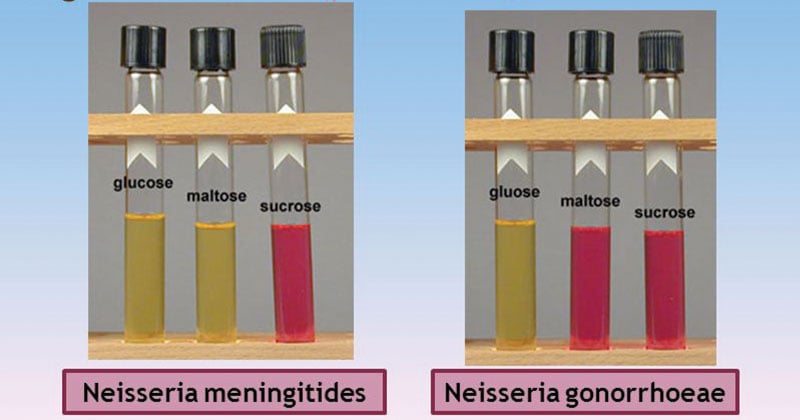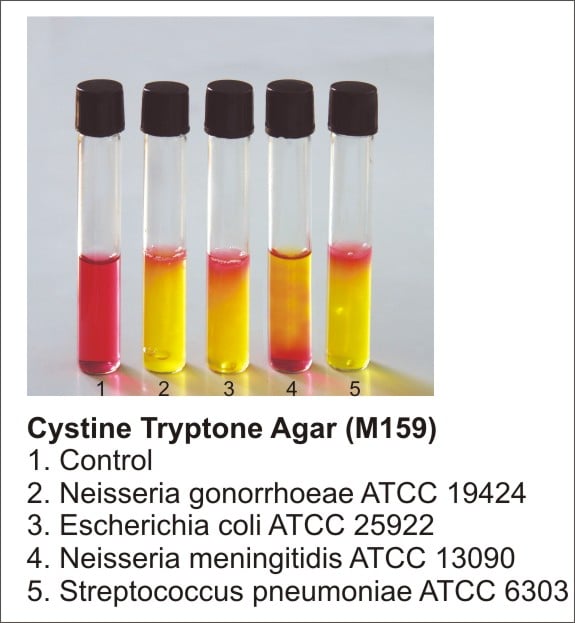Cystine tryptic agar (CTA), also known as cystine trypticase agar, was developed by Vera as a semi-solid growth medium used for the identification and maintenance of microorganisms for extended periods when stored at appropriate temperatures. It is used for the detection of bacterial motility and, with added carbohydrates, it contributes to fermentation reactions and differentiation of fastidious microorganisms such as Neisseria, pneumococci, streptococci, and non-spore-forming anaerobes.
Interesting Science Videos
Composition of Cystine Tryptic Agar
| Ingredients | Gm/L |
| Pancreatic Digest of Casein | 20.0gm |
| Sodium Chloride | 5.0gm |
| L-Cystine | 0.5gm |
| Sodium Sulfite | 0.5gm |
| Phenol Red | 17.0mg |
| Agar | 3.5gm |
Final pH 7.5 +/- 0.2 at 25ºC.
Note: Additionally, CTA Media with carbohydrates contain 10.0gm of the specified carbohydrate.
Principle of Cystine Tryptic Agar
The medium contains cystine and peptone to supply the nutrients necessary to support the growth of fastidious microorganisms. CTA Media supplemented with a 1% concentration of a specific carbohydrate are used to detect fermentation reactions. Carbohydrate fermentation is detected by a visible color change of the medium due to the incorporation of the pH indicator dye, phenol red. When the carbohydrate present is metabolized by the organism, organic acids are produced and the medium becomes acidified. The acid produced by carbohydrate fermentation causes a decrease in pH, causing a color shift in the medium from red-pink to yellow. However, the peptone present in the medium is also degraded by the bacteria present and yields substances that are alkaline in pH. The phenol red indicator changes from reddish-orange to yellow when the amount of acid produced by carbohydrate fermentation is greater than the alkaline end products of peptone degradation. The color change with phenol red occurs around pH 6.8, near the original pH of the medium. The addition of agar to the medium allows for the detection of motility along the stab line of inoculation. The motile organisms extend from the stab line and produce turbidity or cloudiness throughout the medium whereas the non-motile organisms grow only along the stab line and leave the surrounding medium clear.
Preparation of Cystine Tryptic Agar
- Suspend 28.51 grams in 1000 ml distilled water.
- Heat to boiling to dissolve the medium completely.
- Dispense in tubes in 8-10 ml amounts.
- Sterilize by autoclaving at 121°C at 15 lbs pressure for 15 minutes.
- Cool to 50°C and add appropriate carbohydrate.
- Mix well and allow the medium in the test tube to cool in an upright position
Result Interpretation of Cystine Tryptic Agar

Figure: HISS Medium (CTA + Serum + Sugar + Indicator (Phenol Red)). Image Source: slideplayer.com
Fermentation
Positive reaction: development of a yellow color change in the inoculated area (stab line) of the medium.
Negative reaction: a red-pink or deep red color in the medium. Growth with a deep red to orange color in the medium indicates that the carbohydrate has not been utilized and that peptone degradation has occurred.
Motility
Positive test: Turbidity or cloudy growth extends from the line of inoculation.
Negative test: Growth only along the stab line leaving the surroundings clear.

Image Source: HiMedia
Uses of Cystine Tryptic Agar
- It is used for the identification and maintenance of the gonococcus and other bacteria.
- It is used for the determination of carbohydrate fermentation by fastidious microorganisms.
- It is also used for the detection of bacterial motility and additionally the base can serve as a holding medium for the maintenance of fastidious microorganisms.
Limitations of Cystine Tryptic Agar
- It is recommended that biochemical, immunological, molecular, or mass spectrometry testing be performed on colonies from pure culture for complete identification.
- Only small amounts of acid may be produced by Neisseria, as the organisms utilize carbohydrates oxidatively.
- Prolonged incubation may lead to changes in pH indicator or abnormal lactose/sucrose reactions with Neisseria pathogens.
- Aerobic incubation is necessary, as incubation in CO 2 may lead to erroneous results.
- CTA requires a heavy inoculum. Lack of sufficient inoculum may lead to erroneous results.
- Inoculating to the bottom of the tube and improper inoculation may lead to weak acid reactions, thus creating difficulty in test interpretation.
- Peptone utilization results in the production of alkaline by-products. Prolonged incubation may result in a reversion reaction where alkaline by-products mask the acid by-products formed from carbohydrate utilization.
- Because some strains of meningococci, primarily sulfonamide-resistant strains, do not produce acid from maltose, repeated subcultures to non-inhibitory media may be required to restore their maltose-utilizing capability.
- Some strains of gonococci require additional compounds not provided by the CTA Media formulations and will, therefore, not grow on CTA Media.
References
- Hardy diagnostic
- Thermo fisher
- Becton, Dickinson and Company, https://www.bd.com/europe/regulatory/Assets/IFU/Difco_BBL/252310.pdf
- Northeast Laboratory Services
- https://www.nelabservices.com/pdf/tech-sheets/cta-agar.pdf
- Ronald M. Atlas and James W. Snyder. Handbook of media for clinical and public health microbiology. CRC Press. 2014 by Taylor & Francis Group, LLC.
